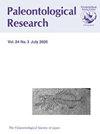Occurrence of Early Carboniferous Radiolarians and Middle Triassic Conodonts from Ban Rai, Southwestern Uthai Thani, Central Thailand and Its Geological Significance
IF 0.6
4区 地球科学
Q3 PALEONTOLOGY
引用次数: 1
Abstract
Abstract. A bedded chert succession, intercalated with layers of coarse-grained sandstone and chert conglomerate, and a limestone block with a long axis of about 10 m are distributed in the Ban Rai area, southwestern Uthai Thani, central Thailand. The chert yielded early Carboniferous (Tournaisian to Visean) radiolarians composed of 10 species of five genera; the limestone yielded Middle Triassic (early Anisian) conodonts comprising five species (P1 element). The lower Carboniferous chert was presumably deposited on the upper continental rise of the Sibumasu Terrane in the Paleotethys Ocean, based on radiolarian faunal characteristics. The Middle Triassic limestone was probably deposited on the continental shelf of the eastern margin of the Sibumasu Terrane, judging from the inclusion of silt-sized quartz grains. Because the blocks of the lower Carboniferous chert and Middle Triassic limestone are currently located in a narrow area, these blocks are inferred to have been mixed with each other by submarine sliding after at least the Middle Triassic at the eastern margin of the Sibumasu Terrane.泰国中部乌泰他尼西南部班莱早石炭世放射虫和中三叠世牙形刺的赋存及其地质意义
摘要泰国中部乌泰他尼西南部Ban Rai地区分布有一个层状燧石序列,夹有粗粒砂岩和燧石砾岩层,以及一个长轴约10m的石灰岩块体。燧石产生了石炭纪早期(图尔奈阶至维斯阶)的放射虫,由五属10种组成;石灰岩产生了中三叠纪(早阿尼斯阶)牙形石,包括五种(P1元素)。根据放射虫动物区系特征,下石炭世燧石可能沉积在古特提斯洋Sibumasu阶地的上陆隆上。根据淤泥大小的石英颗粒的包裹体判断,中三叠纪石灰岩可能沉积在Sibumasu Terrane东部边缘的大陆架上。由于下石炭世燧石和中三叠世石灰岩的块体目前位于狭窄的区域内,这些块体被推断为至少在中三叠统之后在Sibumasu Terrane的东边缘通过海底滑动而相互混合。
本文章由计算机程序翻译,如有差异,请以英文原文为准。
求助全文
约1分钟内获得全文
求助全文
来源期刊

Paleontological Research
PALEONTOLOGY-
CiteScore
1.60
自引率
0.00%
发文量
47
审稿时长
>12 weeks
期刊介绍:
Paleonotological Research (PR) is a quarterly, peer-reviewed international journal, which focuses on original contributions primarily in the area of paleontology but also covering a wide range of allied sciences. It has been published since 1997 as a successor to the former journal Transactions and Proceedings of the Palaeontological Society of Japan. The emphasis of contributions will include global and local perspectives, and contents can cover all ages (Precambrian to the Quaternary, including the present time).
 求助内容:
求助内容: 应助结果提醒方式:
应助结果提醒方式:


